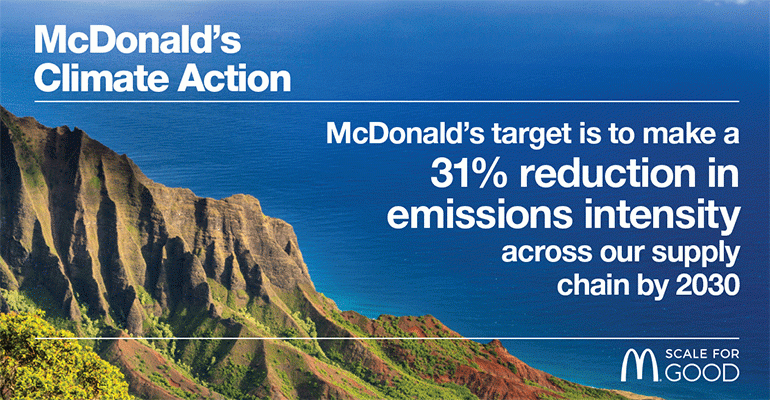In a massive effort to use its influence and restaurants to combat global climate change, McDonald’s on Tuesday set an ambitious goal to cut greenhouse gas emissions 36 percent by 2030.
The Oak Brook, Ill.-based burger giant said it will reach its target by adding innovative and energy-efficient technologies at its restaurants, including energy-efficient kitchen equipment, sustainable packaging and recycling.
“This is the equivalent of taking 32 million passenger cars off the road for an entire year or planting 3.8 billion trees and growing them for 10 years,” the chain said.
McDonald’s CEO Steve Easterbrook said in a statement: “To meet this goal, we will source our food responsibly, promote renewable energy and use it efficiently, and reduce waste and increase recycling.”

Some remodeled restaurants have already adopted new equipment to reduce their carbon footprints, including locations in Riverside, Calif., and Cary, N.C. The restaurants incorporate LED lighting; high-efficiency hand dryers, toilets and faucets; and low-spray valves. The environmentally-friendly upgrades are part of the chain’s goals to reduce energy and increase water efficiency 20 percent in restaurant designs by 2020.
The redesigned restaurants have reported a 16.7-percent reduction in electricity consumption and a 19-percent reduction in water usage from energy-saving equipment, Francesca DeBiase, McDonald’s chief supply chain and sustainability officer, told Nation’s Restaurant News.
With restaurants being renovated regularly around the country, McDonald’s spokeswoman Terri Hickey said there’s “a good chance you are seeing improved LED lighting at your local McDonald’s, though you may not realize it.”
McDonald’s is also investing with universities researching different cattle-grazing methods. Some early testing, which has yet to reach the U.S. supply chain, has shown promise, DeBiase said. Researchers, for example, are seeing “significant soil growth” by rotating cattle when they graze, as opposed to “free-reign” grazing, she said.
McDonald’s said it expects the new emission-reduction goals to prevent 150 million metric tons of greenhouse gases from being released into the atmosphere by 2030.

The company’s goals have been approved by the Science Based Targets Initiative, a coalition that includes World Resources Institute, the World Wide Fund for Nature and the United Nations Global Compact. The group said McDonald’s has become the first global restaurant company to set an emissions reduction target in line with what science says is needed to hold global temperature increases below 2 degrees Celsius.
The science-based target set by McDonald’s on Tuesday is part of the company’s Scale for Good initiative. Earlier this year, the burger giant previously set a goal of having all its packaging come from renewable and recycled sources by 2025.
McDonald’s operates 37,000 restaurants in 120 markets around the world.
Contact Nancy Luna at [email protected]
Follow her on Twitter: @FastFoodMaven





